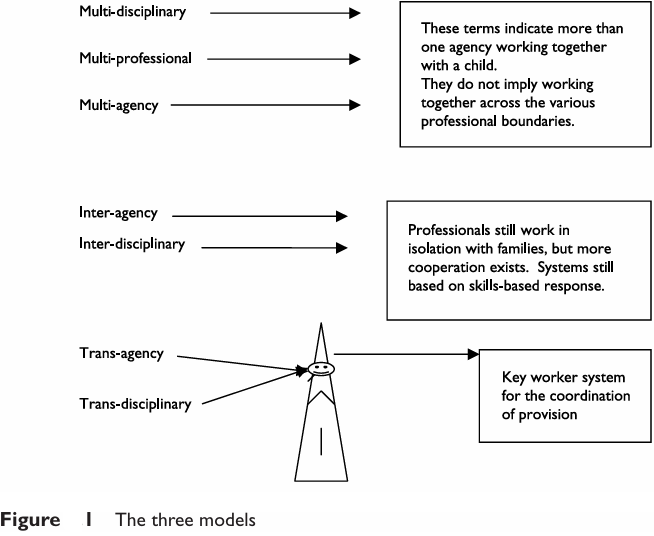


 Grammar
Grammar
 Tenses
Tenses
 Present
Present
 Past
Past
 Future
Future
 Parts Of Speech
Parts Of Speech
 Nouns
Nouns
 Verbs
Verbs
 Adverbs
Adverbs
 Adjectives
Adjectives
 Pronouns
Pronouns
 Pre Position
Pre Position
 Preposition by function
Preposition by function 
 Preposition by construction
Preposition by construction
 Conjunctions
Conjunctions
 Interjections
Interjections
 Grammar Rules
Grammar Rules
 Linguistics
Linguistics
 Semantics
Semantics
 Pragmatics
Pragmatics
 Reading Comprehension
Reading Comprehension|
Read More
Date: 2025-03-28
Date: 2025-03-29
Date: 2025-04-11
|
Trans-disciplinary and trans-agency working
This is considered to be the most developed model, and most effectively supports current philosophies (Wall, 2003), because it clearly recognizes that areas of child development cannot be effectively separated, but are tightly interwoven. Thus, it stands to reason that professionals need to work across disciplines to provide effective responses to a child’s needs. For this reason one of the professionals from the ‘team’ becomes a ‘key worker’ or a ‘primary worker’, and is supported by the others who act like consultants. The key worker will be given the responsibility of coordinating and managing the child’s and his/her family provision. Lacey (2001: 67) vividly clarifies this: ‘In this way, the children are not seen as a combination of legs, hands, speech and intellect, but holistically in terms of their education and care.’ It is also felt that this system is an effective way of supporting families, because it limits the number of professionals that families need to have direct contact with. It is also thought that it helps families to establish a positive working relationship with the professional who is directly responsible for the management of the provision of services and for the passing on of all the information regarding their child or family. Central to this transdisciplinary working model are review meetings and case conferences when all the professionals, parents/carers and, if appropriate, the child, discuss progress, comment on all the various provisions in place and plan for both the short and long term.
Case study
Susan is physically disabled and as such requires the involvement of many medical specialists, social services and all the professionals directly involved with Susans mainstream schooling. During an initial case conference, it was decided that due to the number of professionals involved in Susans provision, a key worker would be the most effective method of making sure that her education and care were managed in a holistic manner. It was felt essential that information, provision and appointments were efficiently coordinated. In this particular case it was felt most appropriate that the parent (who fully supported the move) should take on the key worker role with a lot of support from the social service caseworker.
Despite these clear descriptions, there needs to be a word of warning. When working initially with a different agency or discipline, do not assume that the term ‘trans-agency’ or ‘multi-agency’ will mean the same to them as it does to you. Make sure that all the terminology to be used is clearly understood by all the individuals involved in any meeting or joint project, whether professionals or parents (see Figure 1).
Current legislation and guidance tend to use the term inter-agency working and therefore in an attempt to avoid unnecessary confusion this term will now be used later too.

|
|
|
|
التوتر والسرطان.. علماء يحذرون من "صلة خطيرة"
|
|
|
|
|
|
|
مرآة السيارة: مدى دقة عكسها للصورة الصحيحة
|
|
|
|
|
|
|
نحو شراكة وطنية متكاملة.. الأمين العام للعتبة الحسينية يبحث مع وكيل وزارة الخارجية آفاق التعاون المؤسسي
|
|
|